Why Choosing Alpaca or Wool Socks Impacts Your Brand Positioning
Deciding between alpaca and wool isn’t just about picking a fabric; it’s about building a reputation that customers trust. Comfort, durability, and satisfaction all depend on this choice, shaping how people see your business. Alpaca offers a soft, smooth touch, while wool brings a strong, classic feel. Get it right, and your products match your brand’s values—like quality or sustainability—while keeping shoppers happy. In a busy market, this sets you apart. Choose wisely, and you’ll see more repeat customers, fewer returns, and a stronger presence. Ready to learn more? This guide breaks down alpaca vs wool, digs into what makes them special, and helps your business stand out.
Are wool or alpaca socks better? Alpaca socks are superior to wool for warmth, softness, and comfort. Alpaca fiber is naturally lanolin-free, making it hypoallergenic and preventing the itchiness common with wool. Its hollow core provides better insulation and moisture-wicking, keeping your feet warmer, drier, and more comfortable than traditional wool socks.

Alpaca vs Wool: Material Differences That Affect Performance and Appeal
What Is Alpaca Fiber or Wool? Key Features and Benefits
Alpaca fiber, obtained mainly from alpacas in the Andes, is known for its fine, silky texture and range of natural colors. There are two main breeds—Huacaya and Suri—whose fibers are hollow at the core, leading to excellent insulation without adding bulk. Alpaca contains no lanolin, which makes it hypoallergenic and gentle on sensitive skin. These fibers tend to be long, smooth, and strong, resulting in a soft feel and notable durability. Because of these properties, alpaca socks are often described as having a cloud-like softness similar to cashmere and exceptional warmth. They remain cozy yet lightweight, and the absence of natural oils helps ensure they won’t irritate the skin, making them ideal for those who cannot tolerate traditional wool.
Wool, on the other hand, comes from sheep and features a scaly fiber structure with natural crimp (waviness). This crimp provides elasticity, cushioning, and resilience, while lanolin—wool’s natural oil—adds water resistance and antimicrobial benefits. Merino wool is especially prized for its softness, fineness, and itch-free wear, making it a top choice for premium socks. Lambswool (from a lamb’s first shearing) is also quite soft, whereas some coarser types of wool may feel scratchy against the skin. Wool socks generally deliver warmth, moisture absorption, and breathability, with the fiber’s inherent springiness contributing to a comfortable, cushioned feel.
Softness, Warmth, Breathability & Odor Control: Side-by-Side Comparison
In terms of softness, alpaca’s smoother, finer fibers often give it an edge, especially for those with skin sensitivities. Merino wool can also feel very soft, and high-quality merino socks typically have minimal itch. As for warmth, both alpaca and wool insulate well, but alpaca’s hollow-core structure can trap heat more efficiently. Many find that alpaca socks provide remarkable warmth without the need for thick padding, whereas wool socks (especially merino or thicker wool blends) remain a dependable choice for cold weather, while also allowing breathability when the temperature fluctuates. Overall, alpaca tends to excel in extreme cold or when aiming for a thinner sock, while wool’s blend of warmth and breathability suits a wide range of conditions.
Both fibers do a good job of allowing air circulation and preventing overheating. Wool’s ability to absorb up to 30% of its weight in moisture keeps feet relatively dry by pulling sweat away from the skin. Alpaca fibers wick moisture outward along their hollow core, leading to quicker evaporation. Some experts suggest that alpaca wicks moisture more effectively than sheep’s wool, making it a great option for people with particularly sweaty feet or for activities in damp environments. Regarding odor control, wool’s lanolin has antibacterial properties that naturally resist smells, whereas alpaca’s quick-drying characteristic helps prevent bacterial growth by minimizing dampness. Both materials offer far better odor management than synthetic fibers; alpaca often stays fresh because of its dryness, while wool’s lanolin allows for repeated wear without developing odors.
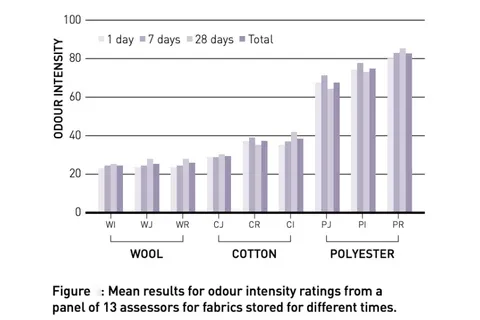
In the end, both alpaca and wool are superb natural options for socks, offering warmth, comfort, and solid moisture management. Alpaca may stand out for its unmatched softness and exceptional moisture-wicking, while wool retains its reputation for reliable, versatile performance. Retailers can market both as high-quality, odor-resistant choices, highlighting alpaca as a top choice for sensitive skin and superior dryness, and wool as the time-tested staple for warmth and durability.
Customer Preferences: Comfort and Performance in Alpaca vs Wool Socks
When comparing alpaca and wool socks for comfort and performance, temperature regulation often tops the list of customer considerations. Alpaca fiber contains tiny air pockets that deliver excellent insulation, meaning alpaca socks can keep feet very warm in frigid temperatures without needing heavy padding. This makes them a good choice for those who want warmth in a slimmer sock, such as under snug boots or dress shoes during winter. Wool (especially merino) also provides reliable insulation and offers the unique ability to adapt to changing conditions: it traps heat when it’s cold but releases warmth if your feet begin to overheat. This dual capability is ideal for activities with varying exertion levels, such as hiking uphill then resting at a cold summit. Overall, alpaca might be the preferred option for people who always have cold feet, while wool’s breathability suits those seeking a versatile sock that transitions seamlessly from chilly mornings to warmer afternoons.
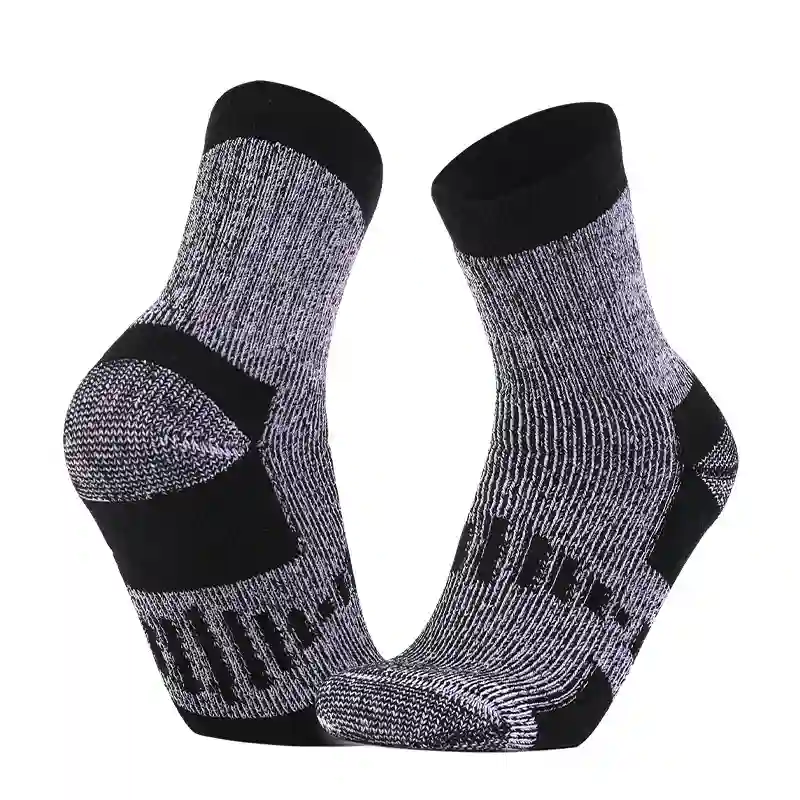
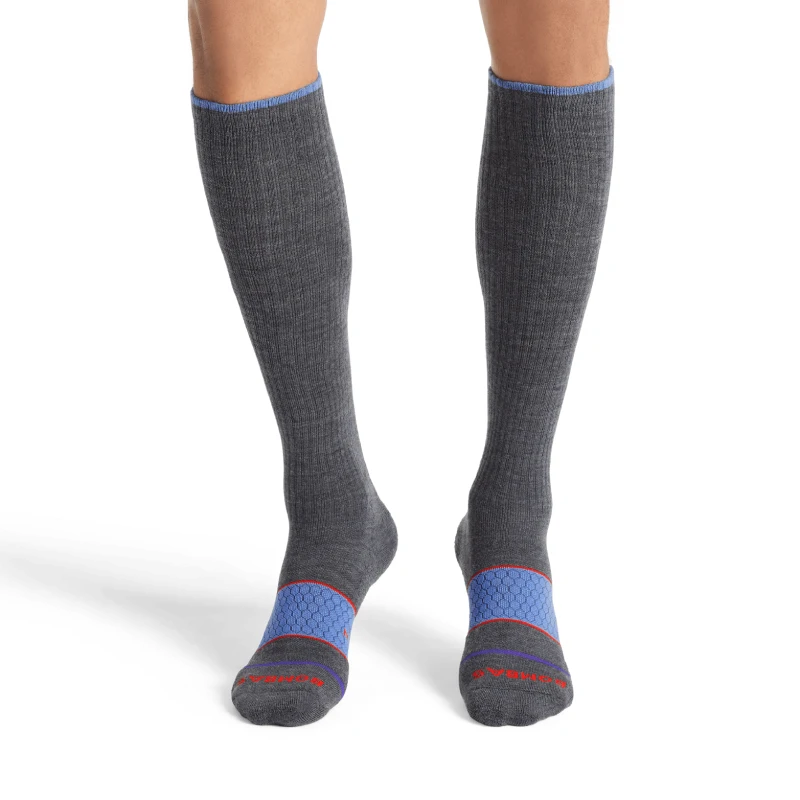
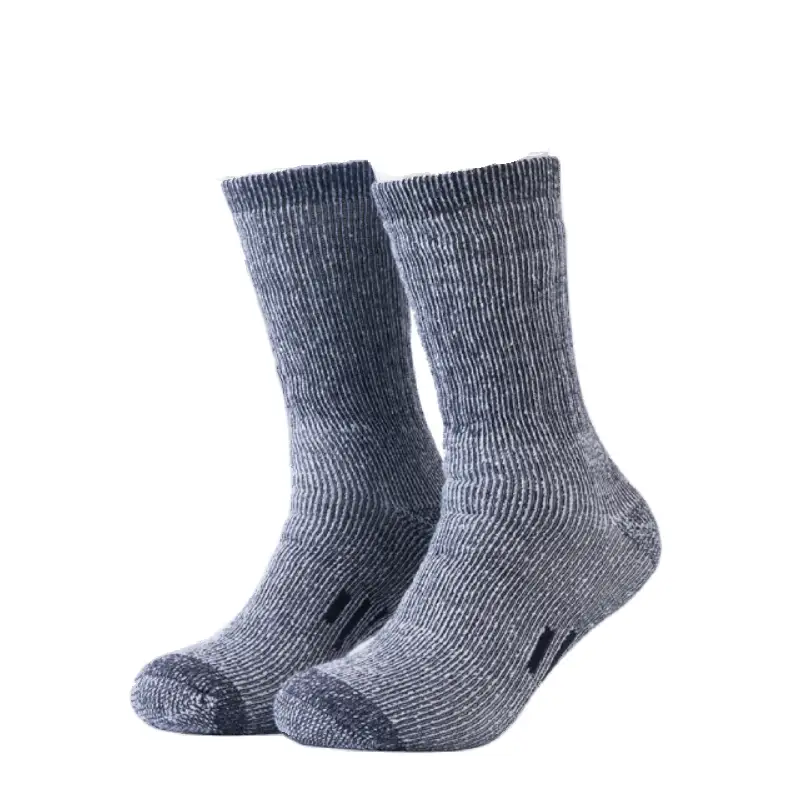
Durability and longevity are critical factors as well. Alpaca fiber has a high tensile strength and tends to resist fraying or pilling, so alpaca socks are often praised for their toughness. Some brands even offer lifetime warranties due to strong confidence in the material’s resilience. Wool fibers, particularly merino, are also durable, though pure wool socks may wear thin at the heels or toes over time unless they’re reinforced. In practice, both alpaca and wool socks typically include small amounts of synthetic materials like nylon or spandex for added stretch and strength. High-quality blends with tight knitting and reinforced high-friction areas can last years, whether they’re alpaca or wool. From a retailer’s perspective, promoting proper care—like gentle washing and air drying—can help customers get the most from their socks. Both materials are long-lasting, but alpaca may have a slight edge in toughness at comparable thickness and weave.
Sensitivity and allergies play a major role in product choice as well. Some people experience itchiness from wool, which can result from coarser fibers or from an allergy to lanolin (the natural oil in sheep’s wool). Merino’s fine fibers greatly reduce the likelihood of irritation, but a small number of wearers still report discomfort. Alpaca fibers, on the other hand, contain no lanolin and have a smoother surface, making them hypoallergenic and far less likely to itch or irritate skin. Many who cannot tolerate wool find that alpaca feels comfortable and soft. For consumers with particularly sensitive skin or conditions like eczema, alpaca socks can be a game-changer. Meanwhile, wool sock brands can reassure buyers by emphasizing the softness of merino. Overall, those who’ve had a bad experience with wool might feel more confident trying alpaca, and retailers can guide them accordingly by highlighting alpaca’s premium comfort benefits.
Alpaca vs Wool Socks: Retail Insights and Which One Sells Better
Pricing and Perceived Value: Alpaca vs Wool Socks in the Market
- Material Cost Differences: Alpaca fiber is relatively rare and often sourced from smaller-scale farms (e.g. in Peru or local alpaca ranches), leading to higher raw material costs. Wool is produced worldwide at large scale, which generally makes wool socks more cost-effective to produce. As a result, alpaca socks usually come with a higher price tag than comparable wool socks.
- Price Points: Wool socks can range from budget-friendly (for basic wool blends or coarse wool) to premium (for high-percentage merino from respected brands). Alpaca socks typically occupy the mid-to-high end of the price spectrum due to their luxury positioning and limited supply. For example, a basic merino hiking sock might retail at $15, whereas a similar alpaca hiking sock could be $20-30+.
- Perceived Value: Consumers often equate price with quality. A higher price on alpaca socks can signal luxury, exclusivity, and superior performance, which certain shoppers are willing to pay for. Wool, being more common, might not seem as “exotic,” but brands like Smartwool or Darn Tough have shown that customers will pay premium prices for high-quality merino wool socks given a strong value proposition (comfort, warranty, brand reputation).
- Retail Consideration: Retailers must balance margin with marketability. Alpaca socks can yield higher margins per unit if priced as a luxury item, but volume might be lower. Wool socks might sell in higher volume, appealing to a broader audience at various price points. The key is to align pricing with the target demographic’s expectations: value shoppers may opt for wool blends, whereas boutique shoppers may appreciate the story and quality behind alpaca.
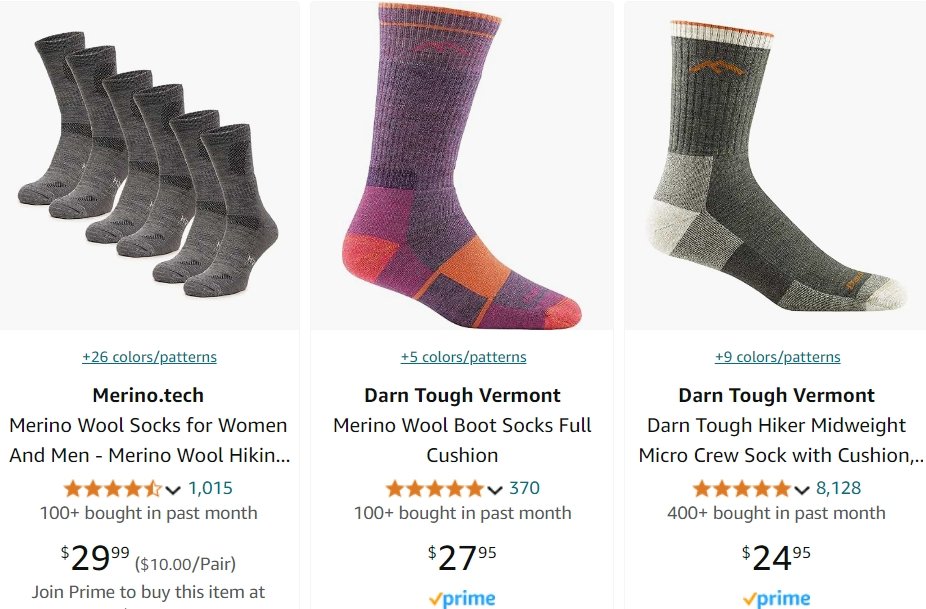
Who Buys Alpaca and Wool Socks? Understanding Target Buyers and Niches
- Alpaca Sock Buyers: Typically, customers who choose alpaca are those looking for premium quality or specific performance benefits. This includes outdoor enthusiasts seeking maximum warmth (mountaineers, skiers who need warm feet), people with cold feet or circulation issues, and those with wool allergies. Alpaca socks also attract gift shoppers and luxury consumers — the uniqueness and “treat factor” of alpaca appeals to people willing to spend more on comfort. Eco-conscious consumers might prefer alpaca if they’ve heard about its sustainable farming aspects.
- Wool Sock Buyers: A very broad group – everyone from hikers and backpackers (who love merino wool’s performance) to working professionals in cold climates (who need warm dress socks) to casual buyers preparing for winter. Wool has wide acceptance; outdoorsy markets trust wool for its long history in performance wear, while everyday consumers know wool as a traditional winter material. Wool socks can target multiple segments: athletes (with merino athletic socks), fashion-conscious folks (with stylish wool blends), and budget-conscious buyers (with basic wool-acrylic blends).
- Market Positioning: Brands that focus on heritage and tradition might highlight wool (“tried and true natural warmth”), whereas brands that emphasize luxury and innovation might highlight alpaca (“the next level of softness and warmth”). Retailers in tourist areas or high-end markets might find alpaca socks popular as an exotic product. In contrast, big-box retailers or outdoor chain stores will have more turnover with wool socks due to brand recognition and established demand. Understanding who your customer is (luxury seeker vs. practical buyer, allergy-prone vs. not, etc.) will guide which sock material will sell better in your store.
Sustainability and Premium Sock Trends: What Buyers Look For in 2025
- Rise of Premium Natural Fibers: Across the apparel industry, there’s a clear trend toward high-quality natural materials. Premium sock brands have elevated what used to be a basic commodity into a specialty item. For example, merino wool socks have become a hallmark of quality for hiking and running, with brands touting features like moisture management and anti-odor in their marketing. Now, alpaca is emerging as a contender in the premium space, with some boutique brands and startups marketing alpaca socks as an even more luxurious upgrade from merino.
- Sustainability Focus: Consumers and brands are gravitating toward sustainability. This means socks made from biodegradable, ethically sourced fibers are gaining popularity over synthetic socks. Both alpaca and wool fit into this trend as natural, renewable fibers. Many premium sock companies now highlight their sustainable sourcing – for instance, using Responsible Wool Standard-certified wool or partnering with alpaca farms that follow eco-friendly practices.
- Niche and Storytelling Brands: Smaller sock brands are differentiating themselves with unique stories and materials. Alpaca socks often come with a compelling narrative (Andean heritage, family-run farms, hand-crafted processes) that adds to their appeal in the premium market. Wool sock brands might emphasize their legacy (e.g., an old mill producing wool socks for a century) or technology (like a new knit that improves comfort). The trend is that storytelling and transparency around materials are key – whether it’s “sourced from high-altitude Peruvian alpacas” or “merino wool from sustainable New Zealand farms,” these details attract modern consumers.
- Design and Fashion Trends: Premium doesn’t just mean better materials; it also means stylish design. We see trends like minimalist, earth-tone alpaca socks in the eco-fashion world, or bold-patterned wool socks in the hipster/craft fashion scene. Brands are combining the functional benefits of alpaca and wool with trendy aesthetics, making these socks not just comfortable but also Instagram-worthy. Retailers should note that socks are now a fashion statement as much as a functional item, and stocking eye-catching, high-quality options in wool or alpaca can cater to this trend.
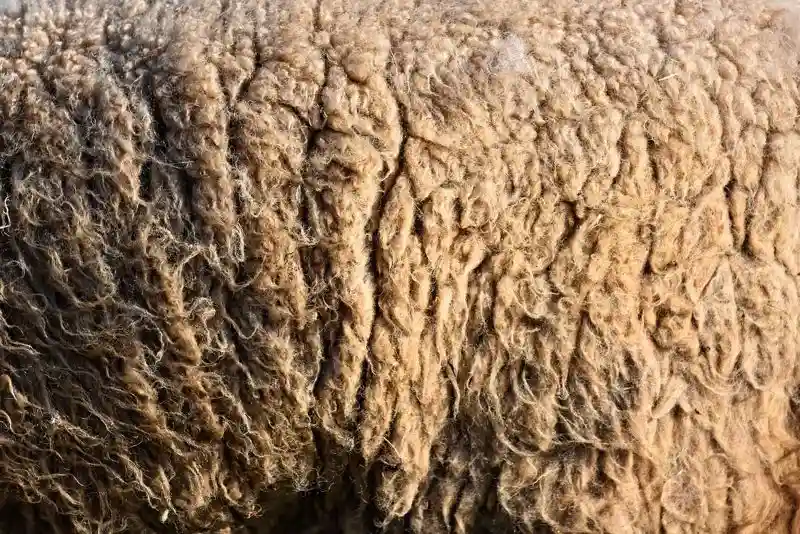
Sustainable & Ethically Sourced Socks: Key Insights for Brands
Alpacas, with their soft padded feet and gentle grazing habits, generally cause less soil compaction than sheep. Likewise, removing lanolin from sheep’s wool involves substantial water and chemicals, whereas alpaca fiber requires only minimal scouring. Because many alpaca farms operate on smaller, mixed-use land, they may also produce lower methane emissions. For environmentally focused brands, responsibly sourced fibers from regenerative practices can be a strong selling point.
Caring for animals and supporting local communities are both crucial to maintaining ethical standards. In the wool industry, many suppliers now reject painful procedures like mulesing. Fair Trade cooperatives further promote fairness by providing small-scale growers with equitable payments and better livelihoods. Transparent supply chains backed by recognized certifications reassure customers that their wool socks are both humane and eco-friendly.
As consumers become more eco-conscious, natural-fiber socks offer a biodegradable option that avoids microplastic pollution. Highlighting responsible production methods—such as using reduced-impact dyes and minimal packaging—helps attract conscientious buyers. By educating shoppers on these benefits, you can nurture trust and ensure your brand stands out in an increasingly green marketplace.
Custom Sock Options: Material Blends, Colors, Logo Placement & Design Tips
Brands have several ways to customize socks to meet specific needs and appeal to their target audience. One important consideration is the choice of material blends. A custom sock might blend alpaca and merino wool to harness the strengths of both fibers, or it could include synthetic fibers like nylon or spandex for additional stretch and durability. The decision to use a 100% natural fiber or a blended composition often depends on consumer preferences: purists may insist on pure alpaca, while performance-focused users may be open to blends that improve fit and resilience.
Color and pattern customization offers another level of creative freedom. Both alpaca and wool fibers can be dyed in a wide range of colors, although alpaca has the added advantage of beautiful natural hues (including cream, brown, grey, and black) that can be showcased without dye. Brands can select signature colors or follow seasonal palettes to create distinctive looks, incorporating patterns such as stripes, argyle, or novelty prints that reflect their aesthetic. An outdoor brand might add a mountain silhouette design on merino wool socks, while a fashion-forward boutique could opt for a cozy cable-knit alpaca sock in neutral shades.
Design features go beyond aesthetics to enhance function. Choices include the level of cushioning (from a lightweight dress sock to a thick cushioned boot sock), sock height (ankle, crew, or knee-high), and special functional elements like compression bands, reinforced heels and toes, or seamless toes to boost comfort. Logos or branding details can be embroidered or printed on the cuff, ensuring the socks align with brand identity. These customization options enable a company to cater to a specific niche, whether that’s luxurious lounge socks or rugged hiking footwear.
Finally, packaging and branding can further elevate the customer experience. Customized labels, eco-friendly wrapping, or an elegant gift box can all make a memorable impression—especially when marketing premium alpaca socks as gifts or high-end items. Presenting the socks in a thoughtful way reinforces the brand’s image and adds tangible value for the customer.
Final Thoughts: Choosing Between Alpaca and Wool Socks for Your Brand
Choosing between alpaca or wool socks is not only about materials, but also about building brand trust. Alpaca socks offer ultimate warmth and hypoallergenic properties, appealing to luxury-seeking consumers; wool socks offer classic, long-lasting performance to meet the needs of the general public. Both support customization and green certification, helping you stand out in the market competition.
Contact us now to get a natural fiber sock solution that balances performance and profitability.
FAQs
Are Alpaca Socks Warmer Than Wool Socks?
Customers frequently ask this, especially if they’re comparing a pricey alpaca pair to their trusty wool socks. You can explain that alpaca fiber has a unique hollow core that traps heat very effectively, providing great insulation. This means alpaca socks can keep feet warmer with a lighter weight sock, which is why alpaca is famed for warmth.
Which Socks Are Better for Outdoor and Winter Activities?
Advise customers based on activity intensity and conditions. For high-intensity activities (long hikes, mountain biking), merino wool socks might be preferable because they are proven to manage sweat over long periods and usually come in various cushioning options from trusted outdoor brands. For low to medium intensity in very cold conditions (snowshoeing, winter camping nights, hunting from a blind where you sit still), alpaca socks might keep feet warmer when there’s less body heat being generated.
Are Alpaca and Wool Socks Machine Washable?
Generally, both alpaca and wool socks can be machine washed on a gentle cycle with cold water, but air drying is recommended. To reduce customer concerns, provide clear care instructions with the product or on your website. Perhaps even suggest gentle detergent brands. Emphasize that taking a bit of extra care (washing in cold, not tossing in a hot dryer) will ensure the socks last a long time and maintain their fit. Highlight that these minor inconveniences are a trade-off for owning natural-fiber socks that offer superior comfort and sustainability.
Do Factories Assist with Design Consultation?
Many do. They can offer advice on yarn types, coloration, or technical elements to ensure your custom sock aligns with your brand vision.
What Printing or Embroidery Options Are Available for Branding?
Branding can be incorporated through jacquard knitting, embroidery, or heat transfer printing, depending on the fiber type and design complexity.
